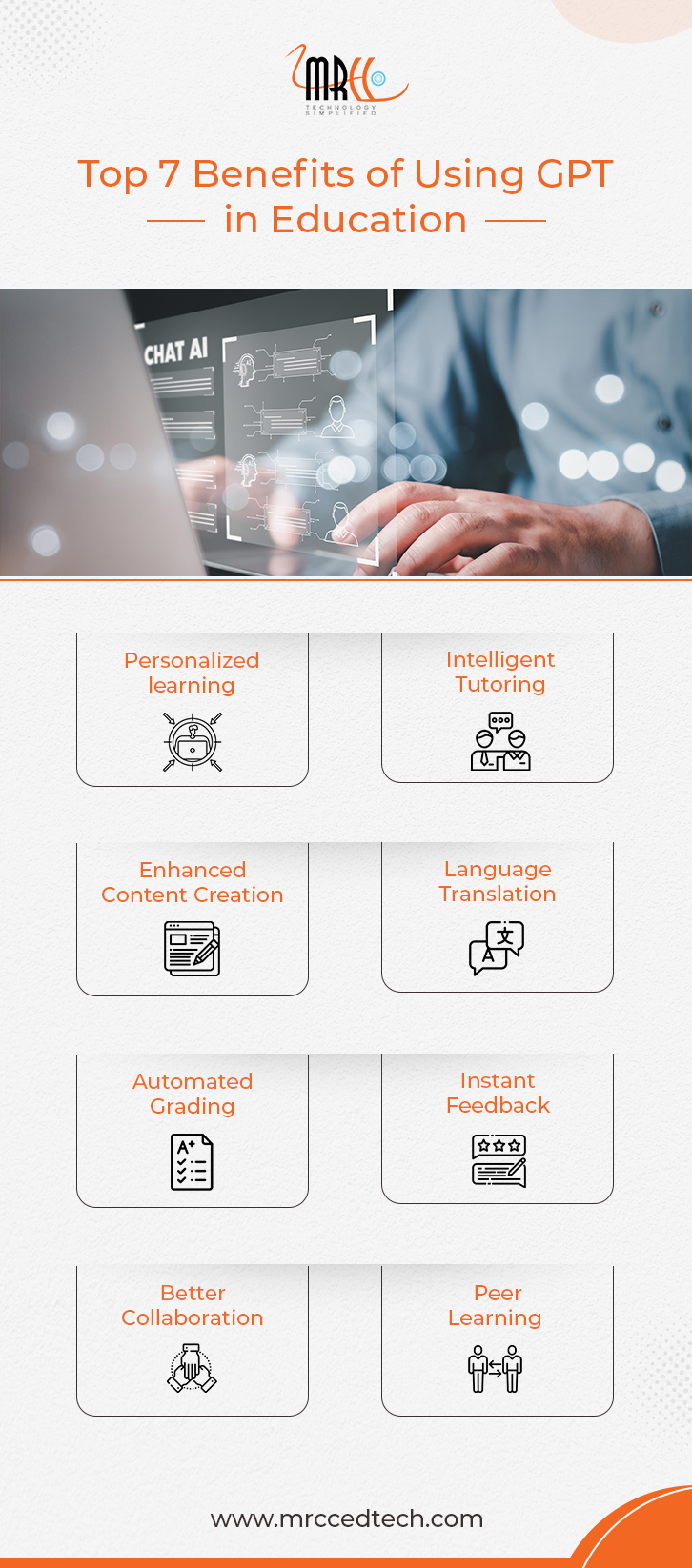Sep 4 2023
Unleashing the Power of AI & GPT in Education: Transforming Digital Learning Experiences

VP Learning Solutions

Sep 4 2023

VP Learning Solutions

The value of the AI-led education market is estimated to cross $20 Billion by 2027. In today’s rapidly evolving world, educational institutions and EdTech publishers are continuously seeking innovative ways to enhance digital learning experiences for students. Artificial Intelligence (AI) and specifically the cutting-edge technology of Generative Pre-trained Transformers (GPT) have emerged as game-changers in the field of education. According to a Datamation report, 86% of educators believe AI technology must be an integral part of the learning process.
This blog highlights the transformative applications of AI and GPT and sheds light on the immense potential they hold for revolutionizing digital learning for educational institutions, publishers, and EdTech companies.
In education, AI delivers a highly personalized learning experience. By analyzing individual learner data, AI systems can adapt the learning content, learning pace, and instructional strategies to meet the specific needs and preferences of each learner. When AI detects a student hasn’t grasped a concept adequately, it can intelligently generate targeted recommendations in real time.
These personalized recommendations aim to provide additional resources and supplementary learning materials or even suggest alternative learning paths to ensure learners get a deeper understanding of the topic at hand. This tailored approach fosters better engagement, improved retention, and enhanced learning outcomes. Using AI in education for personalized learning can increase student engagement by 20% as compared to traditional learning.

AI-powered systems equipped with GPT technology have the remarkable ability to provide meaningful and constructive feedback to students when they submit incorrect answers. Rather than simply marking an answer as wrong, AI can analyze the misconceptions or gaps in understanding displayed by the student’s response and tailor its feedback accordingly.
To make the interface user-friendly, an LMS can provide a dedicated button to generate a response. When students click on this button, the system will generate an answer that closely aligns with the expected response, accompanied by a detailed explanation within a predetermined word limit. Using AI and GPT in K-12 and higher education to generate informative responses for wrong answers will help students grasp the concept effectively.
Integrating AI and GPT technology in universities and K-12 education can empower students to assess their understanding of course topics whenever they want. By incorporating an intuitive interface within the course, students can generate questions on the go. This will enable them to self-assess their subject knowledge. The question generator can utilize GPT’s natural language processing capabilities to create well-structured, contextually relevant questions that challenge and stimulate students’ critical thinking skills.
These AI-powered question generators can produce an extensive pool of questions, ensuring students are presented with a variety of assessments that cater to their individual learning needs. This eliminates the human effort required for creating test banks and assessments.

AI and GPT technology in higher education offers a streamlined solution for University Instructional Designers (IDs) and faculty members to chunk raw content according to specific Learning Objectives (LOs). University IDs/faculty can upload the raw learning content as input into the GPT model and obtain the desired output. This refined learning content is structured into smaller chunks based on predefined criteria.
This automated process significantly reduces the time and effort required by IDs/faculty, optimizing their workload and allowing them to focus on other essential tasks related to course development.
According to research conducted in 2019, learning content was not accessible on over 70% of all university websites. By leveraging AI-powered tools, educational institutions and EdTech publishers can auto-generate accessible content that adheres to accessibility standards. GPT technology can help produce alternative text descriptions for images, provide audio descriptions, or generate captions for videos. This enables students with visual impairments or hearing difficulties to easily access content.
Users can simply upload images or videos as input, and AI algorithms will generate relevant alt-texts or video descriptions automatically. This automation significantly reduces the effort and turnaround time required to make content accessible.
By leveraging AI, learning systems can analyze, understand, and identify positive and negative sentiment words within student postings. These sentiment words can then be fed into the GPT model for sentiment analysis and topic modeling. The AI system will generate daily reports, highlighting important keywords and offering a comprehensive understanding of learners’ sentiments.
This approach proves particularly beneficial in understanding how students respond to policy changes and in introducing new learning areas. Moreover, sentiment analysis can be extended to social media platforms. This will provide a broader understanding of student sentiments and facilitate proactive measures to address concerns and create a positive, engaging learning environment.
To ensure high-quality learning content for education, AI and GPT technology can be implemented through a plugin designed to check grammar, spelling, punctuation, cultural nuances, and writing style errors. This plugin can automatically detect and correct grammar and syntax mistakes, ensuring accurate and error-free content. It also ensures culturally appropriate and consistent learning material.
Integrating this plugin reduces the need for extensive human intervention and efforts, streamlining the proofreading process. As a result, educational institutions and EdTech publishers can deliver polished content that upholds high standards without compromising on efficiency or quality.
It’s a no-brainer that AI-powered systems are more efficient than human beings in the research and fact-checking process of vast volumes of research papers and other relevant sources. AI-led models can easily ingest a defined or extensive pool of literature within a specific subject area. Researchers can input specific sets of words or questions, enabling the tool to analyze and extract the most relevant and precise information.
This approach provides learners with more targeted insights. The benefits of this research assistance tool are manifold, including a quicker research process, reliable and accurate information, and reduced time and effort. The strategic use of AI for universities will help research students become more efficient and grow faster.
As educational institutions and EdTech publishers embrace the potential of AI-based learning solutions, they pave the way for a future of digital learning that is dynamic, inclusive, and optimized for student success. By leveraging the transformative capabilities of GPT technology, you can revolutionize digital learning and empower learners with boundless growth opportunities.
If you are looking to enhance the learning experience and outcomes for your students, get in touch with our EdTech experts. Empower your students’ learning journey with our state-of-the-art digital learning solutions.

Leave A Reply
Your email address will not be published. Required fields are marked *